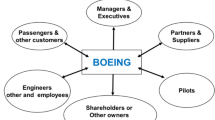Abstract
This article explores the concepts of safety culture and safety climate in an attempt to determine which is the more useful for describing an organization's “state of safety.” From a review of the literature purporting to measure safety culture or safety climate, it is argued that, although the two terms are often interchangeable, they are actually distinct but related concepts and should be treated accordingly. The term “safety climate” best describes employees' perceptions, attitudes, and beliefs about risk and safety, typically measured by questionnaire surveys and providing a “snapshot” of the current state of safety. “Safety culture” is a more complex and enduring trait reflecting fundamental values, norms, assumptions and expectations, which to some extent reside in societal culture. The expression of these “cultural” elements, perhaps, can be seen through safety management practices which are reflected in the safety climate. Basically, measurement of safety culture requires in-depth investigation including an analysis of how organizational members interact to form a shared view of safety.
Similar content being viewed by others
References
ACSNI. (1993). Human factors study group third report: Organising for safety. London: HMSO.
Alexander, M., Cox, S., and Cheyne, A. (1995). UK Offshore Safety Culture. Paper presented at the “Understanding Risk Perception” Conference. Aberdeen, February.
Ashforth, B. (1985) Climate formation—issues and extensions. Academy of Management Review, 18(4), 837–847.
Brown, R.L. and Holmes, H. (1986). The use of factor-analytic procedure for assessing the validity of an employee safety climate model. Accident Analysis and Prevention, 18, 289–297.
Blackmore, G.A. (1997). Leading performance indicators. Paper presented at the IADC North Sea Seminar, Performance Measures for Safety Management. Aberdeen, June.
Cooke, R.A. and Rousseau, D.M. (1988). Behavioural norms and expectations: A quantitative approach to the assessment of organizational culture. Group and Organisational Studies, 13(3), 245–273.
Cooper, M.D. (1998). Improving safety culture. A Practical Guide. Chichester: Wiley.
Cox, S. (1996). Maximising performance: The impact of positive safety culture. Paper presented at the 5th Offshore Installation Managers Conference, April, Aberdeen.
Cox, S. and Cox, T. (1991). The structure of employee attitudes to safety: a European example. Work and Stress, 5, 93–106.
Cox, S. and Cox, T. (1996). Safety, systems and people. Oxford: Butterworth-Heinemann.
Cox, S. and Flin, R. (1998). Safety culture: Philosopher's stone or man of straw? Work and Stress (special issue on safety culture), 12(3), 189–201.
Denison, D. (1996). What is the difference between organisational culture and organisational climate? A native's point of view on a decade of paradigm wars. Academy of Management Review, 21(3), 619–654.
Glick, W. (1985). Conceptualising and measuring organisational and psychological climate: Pitfalls in multilevel research. Academy of Management Review, 10, 601–616.
Guest, D, Peccei, R., and Thomas, A. (1994). Safety culture and safety performance: British Rail in the aftermath of the Clapham Junction disaster. Unpublished paper.
International Nuclear Safety Advisory Group. (1991). Safety culture. Safety Series No 75-INSAG-4. Vienna: International Atomic Energy Agency (IAEA).
Kaplan, R.S. and Norton, D.P. (1996). The balanced storecard. Boston: Harvard Business School.
Kopelman, R., Brief. A. and Guzzo, R. (1990). The role of climate and culture in productivity. In B. Schneider (ed.), Organisational Climate and Culture. Oxford: Jossey Bass.
Lee. T.R. (1995). The role of attitudes in the safety culture and how to change them. Paper presented at the Conference “Understanding Risk Perception.” Aberdeen, February.
Lewin. K. (1951). Field theory in social science. New York: Harper and Row.
Mead, M. (1934). Mind, self and society. Chicago: University of Chicago Press.
Mearns, K., Flin, R., Fleming, M., and Gordon, R. (1997). Human and Organisational Factors in Offshore Safety. OTH 87 543. Suffolk: HSE Books.
Mearns, K., Flin, A., Gordon, R., and O'Connor, P. (1997). Factoring the human into safety: Translating research into practice. Research Paper. Department of Psychology, University of Aberdeen.
Moran, E. and Volkwein, J. (1992). The cultural approach to the formation of organisational climate. Human Relations, 45 (1), 19–47.
OECD Nuclear Agency. (1987). Chernobyl and the safety of nuclear reactors in OECD countries. Paris: Organzation for Economic Co-operation and Development.
Pidgeon, N. (1991). Safety culture and risk management in organisations. Journal of Cross-Cultural Psychology, 22, 129–140.
Pidgeon, N. (1995). Risk construction and safety culture in managing high-risk technologies. Paper prepared for International Workshop on Institutional Vulnerabilities and Resilience in Public Administration, Crisis Research Centre. Leiden, The Netherlands.
Reason, J. (1997). Managing the risks of organizational accidents. Aldershot: Ashgate.
Rousseau, D. (1988). The construction of climate in organisational research. In: C. Cooper and I. Robertson (eds.) International Review of Industrial and Organisational Psychology. Chichester: Wiley.
Schein, E. (1984). Coming to a new awareness of organisational culture. Sloan Management Review, 25(2), 3–6.
Schneider, B. (1975). Organisational climate: Individual preferences and organisational realities revisited. Journal of Applied Psychology, 60, 459–465.
Schneider, B. (1990). Organisational Climate and Culture. Oxford: Jossey Bass.
Schneider, B. and Gunnarson, S. (1996). Organisational climate and culture: The psychology of the workplace. In: J. James, B. Steffy and D. Bray (eds.), Applying Psychology in Business. Mass: Lexington.
Turner, B., Pidgeon, N., Blockley, D., and Toft, B. (1989). Safety culture: Its importance in future risk management. Position paper for Second World Bank Workshop on Safety Control and Risk Management. Karlstad, Sweden.
Turner, B. and Pidgeon, N. (1997). Man-made disasters (2nd Ed.). London: Butterworth.
Williamson, A., Feyer, A-M., Cairns, D., and Biancotti, D. (1997). The development of a measure of safety climate: the role of safety perceptions and attitudes. Safety Science, 25 (1-3), 15–27.
Zohar, D. (1980). Safety climate in industrial organisations: Theoretical and applied implications. Journal of Applied Psychology, 65 (1), 96–102.
Author information
Authors and Affiliations
Rights and permissions
About this article
Cite this article
Mearns, K.J., Flin, R. Assessing the state of organizational safety—culture or climate?. Curr Psychol 18, 5–17 (1999). https://doi.org/10.1007/s12144-999-1013-3
Issue Date:
DOI: https://doi.org/10.1007/s12144-999-1013-3




